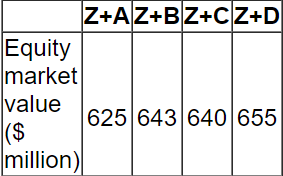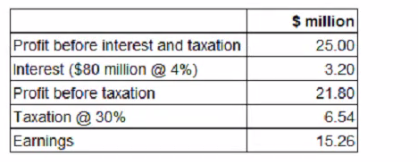CIMA F3 - Financial Strategy
Company Z has identified four potential acquisition targets: companies A, B, C and D. Â
Company Z has a current equity market value of $580 million.
The price it would have to pay for the equity of each company is as follows: Â
  
Only one of the target companies can be acquired and the consideration will be paid in cash.
The following estimations of the new combined value of Company Z have been prepared for each acquisition before deduction of the cash consideration:
 Â
Â
Ignoring any premium paid on acquisition, which acquisition should the directors pursue?
Which THREE of the following long term changes are most likely to increase the credit rating of a company?
A company proposes to value itself based on the net present value of estimated future cash flows.
Â
Relevant data:
   • The cash flow for the next three years is expected to be £100 million each year
   • The cash flow after year 3 will grow at 2% to perpetuity
   • The cost of capital is 12%
The value of the company to the nearest $ million is:
The following information relates to Company A's current capital structure:
  
Company A is considering a change in the capital structure that will increase gearing to 30:70 (Debt:Equity).Â
Â
The risk -free rate is 3% and the return on the market portfolio is expected to be 10%.
The rate of corporate tax is 25%
Â
Using the Capital Asset Pricing Model, calculate the cost of equity resulting from the proposed change to the capital structure.
A company has a 4% corporate bond in issue on which there are two loan covenants.
• Interest cover must not fall below 4 times
• Retained earnings for the year must not fall below S5 00 million
The Company has 100 million shares in issue. The most recent dividend per share was $0 10 The Company intends increasing dividends by 8% next year.
Financial projections tor next year are as follows:

Advise the Board of Directors which of the following will be the status of compliance with the loan covenants next year?
A company has two divisions.
A is the manufacturing division and supplies only to B, the retail division.
The Board of Directors has been approached by another company to acquire Division B as part of their retail expansion programme.
Division A will continue to supply to Division B as a retail customer as well as source and supply to other retail customers.
Which is the main risk faced by the company based on the above proposal?
D has US$10 million to invest over 12 months in either USS or GBP Its options are to invest in USS at the present USS interest rate of 10 18%. or to convert the USS to GBP at the spot rate GBP1 =US$1 61 and invest in GBP at an interest rate of 6.4%.
According to the interest rate parity theory, what will the one year forward rate be?
Give your answer to three decimal places.

A company is currently all-equity financed.
The directors are planning to raise long term debt to finance a new project.
The debt:equity ratio after the bond issue would be 30:60 based on estimated market values.
Â
According to Modigliani and Miller's Theory of Capital Structure without tax, the company's cost of equity would:
A company has borrowings of S5 million on which it pays interest at 8%. It has an operating profit margin of 20%.
The company plans to increase borrowings by S2 million Interest on additional borrowings would be 10% and the operating profit margin would remain unchanged
A debt covenant attached to the new borrowings requires interest cover to be at least 4 times throughout the period of the borrowing
Interest cover is defined in the loan documentation as being based on operating profit
What is the minimum sales value required each year to avoid a breach of the interest cover covenant'
A company currently has a 5.25% fixed rate loan but it wishes to change the interest style of the loan to variable by using an interest rate swap directly with the bank.
The bank has quoted the following swap rate:
* 4.50% - 455% in exchange for Libor
Libor is currently 4%.
If the company enters into the swap and Libor remains at 4%. what will the company's interest cost be?



